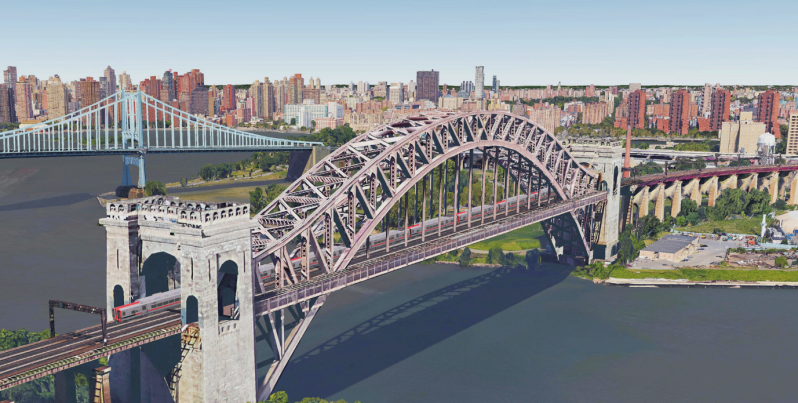Four New Bronx Metro-North Stations Are A Good Time to Talk about Fair Rail Fares

All aboard?
Gov. Cuomo said on Thursday that the COVID-stalled Metro-North Penn Access project, which will add four new Metro-North stations in the East Bronx, is back on schedule. The bad news? The governor didn’t mention anything about ensuring that the fares are affordable to the very people he hopes to serve.
The new stations, in Co-op City, Morris Park, Parkchester and Hunts Point, will give tens of thousands of people new access to commuter rail service to Penn Station along a new stretch called Hell Gate Line. But with those stations set to open in 2025, advocates reminded the MTA that it’s high time to create an equitable fare structure for intra-city commuter rail riders.
“Penn Access is very important for East Bronx communities with long subway or bus-plus-subway rides to Midtown,” said Riders Alliance Policy and Communications Director Danny Pearlstein. “But the service needs to be brought within economic reach of Bronx riders to make it a worthwhile project. The governor should overhaul the commuter rail fare structure within city limits to build ridership and create equitable access to opportunity.”
Intra-city service on the MTA’s existing commuter rail lines is, frankly, expensive. Even a reduced-fare LIRR trip taken entirely inside the city typically $7. On Metro-North, a rush hour ride between Riverdale and Grand Central costs $9.75 (off-peak is $7.25). No wonder Southeast Queens resident Samuel Santaella called the commuter rail system a kind of transportation apartheid in 2020.
The MTA has moved very slowly to provide fair fares on commuter rail inside the city for the actual population that lives here. Most notably, the agency’s Atlantic Ticket, a $5 fare for travel between Atlantic Terminal and southeast Queens, was so popular that it netted the MTA over $10 million in revenue in under two years. That success led to calls by the Permanent Citizens Advisory Committee to the MTA for the ticket option to be expanded to select Metro-North stations, and eventually to every commuter rail station in New York City.
Comptroller Scott Stringer has also prodded the MTA to better integrate itself within the city’s transportation system, by calling for a $2.75 fare and free bus or subway transfer for every intra-city trip on the LIRR and Metro-North station in the city.
There’s no indication that the MTA will wholeheartedly embrace a future where riders can take advantage of cheap commuter trains inside New York City limits, but agency leadership has at least noted that riders in the city will be a key part of the recovery for the pandemic-devastated agency, especially since weekday ridership is still hovering at around 25 and 30 percent of regular ridership numbers on the LIRR and Metro-North respectively.
“Commuter rail, like Metro-North and Long Island Railroad are lagging the other parts of the agency and that’s likely to be the case of going forward,” MTA Chairman and CEO Pat Foye said on a panel at the Regional Plan Association’s annual assembly last Friday. “The thing that we’re likely to see is more local service. For instance, Metro-North has stops in the Bronx, but trains generally don’t stop at Fordham Road stations during the morning and evening rush, so I think we have an opportunity to serve those communities. Same thing with respect to the Long Island Rail Road, which obviously has local stops in Brooklyn and Queens. I think there’ll be more service to those areas, some of which aren’t otherwise, transportation, deserts.”
Transit thinkers are saying that with four new stations coming online soon, and with ridership on commuter rails still depressed as big brain thinkers consider the commuting patterns of the future, the time to fully to commit to attracting ridership on these trains is now.
Cuomo says this will be completed within 4 years. Fare rationalization and more frequent service become paramount concerns to make this truly useful.
— Second Ave. Sagas (@2AvSagas) May 13, 2021
“We’re hopeful that it would be at a cost low enough to encourage ridership and potentially include transfers to subways and buses,” PCAC Executive Director Lisa Daglian said about the price structure of intra-city rides out of the new Bronx stations when Penn Access is finished.
The failure of the state agency to discuss pricing could not fully distract from the good news of the new $1.6-billion service, which was announced in a rollicking jazz-scored video that hyped the reduced travel times for east Bronx residents, whether traveling to Midtown or up the new line to points north. Hour-plus trips to Penn Station — currently a bus-to-subway slog — will now take under a half hour from every new station.
This is the stuff that gets me out of bed every morning (at 5:45A) pic.twitter.com/JIIhSqnc7i
— Kevin (@kevinjcall) May 13, 2021
Per the transit agency, the project will irrigate a parched transportation desert by taking advantage of existing Amtrak tracks that cut through the four neighborhoods — neighborhoods with a median income of roughly $42,000 a year, or 32 percent lower than the citywide average.
“The most cost-effective capital projects are those that squeeze more mass transit service out of existing infrastructure, rather than always building something new from scratch,” said Janno Lieber, president of MTA Construction and Development. “By rebuilding this under-utilized Amtrak rail line to accommodate new Metro-North service, this project will give East Bronx residents better access to jobs, education and a full range of opportunities.”





